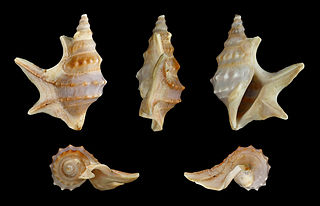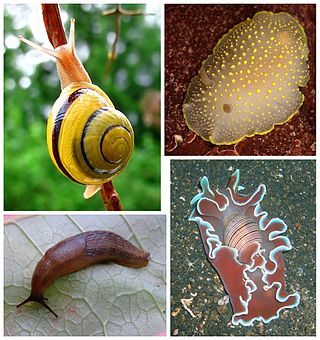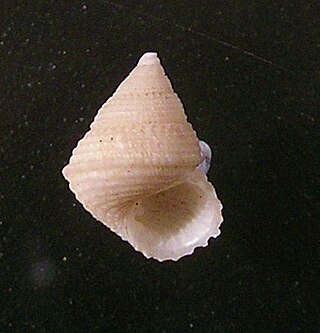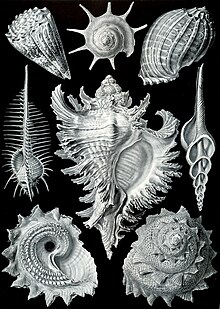
Gastropods, commonly known as slugs and snails, belong to a large taxonomic class of invertebrates within the phylum Mollusca called Gastropoda.

Opisthobranchs is a now informal name for a large and diverse group of specialized complex gastropods which used to be united in the subclass Opisthobranchia. That taxon is no longer considered to represent a monophyletic grouping.

Archaeogastropoda was a taxonomic order of sea snails used in older classifications of gastropods, i.e. snails and slugs. Archeogastropoda are marine prosobranch gastropod mollusks, mainly herbivores, typically having two gills and a double-chambered heart, with the eggs and sperm discharged directly into the water. They were traditionally regarded as a relatively primitive group.

Karl Hermann Johannes Thiele was a German zoologist specialized in malacology. Thiele was born in Goldap, East Prussia. His Handbuch der systematischen Weichtierkunde is a standard work. From 1904 until his retirement in 1925 he was the curator of the malacological collection at the Museum für Naturkunde in Berlin. Thiele described more than 1.500 new species of molluscs; until today their types are deposited with the Museum of Natural History in Berlin. Especially important are his works on the Mollusca of the First German Antarctica Expedition and of the German Deep Sea Expedition aboard the vessel Valdivia.

Mesogastropoda was for many years a traditional taxonomic group of snails, an order. The order was composed mostly of sea snails, but it also included some land snails and freshwater snails, all of which were prosobranch gastropod mollusks.

Neogastropoda is an order of sea snails, both freshwater and marine gastropod molluscs.

Heterobranchia, the heterobranchs, is a taxonomic clade of snails and slugs, which includes marine, aquatic and terrestrial gastropod mollusks.

The order Cephalaspidea, also known as the headshield slugs and bubble snails, is a major taxon of sea slugs and bubble snails, marine gastropod mollusks within the larger clade Euopisthobranchia. Bubble shells is another common name for these families of marine gastropods, some of which have thin bubble-like shells. This clade contains more than 600 species.

Pulmonata or pulmonates, is an informal group of snails and slugs characterized by the ability to breathe air, by virtue of having a pallial lung instead of a gill, or gills. The group includes many land and freshwater families, and several marine families.

Caenogastropoda is a taxonomic subclass of molluscs in the class Gastropoda. It is a large diverse group which are mostly sea snails and other marine gastropod mollusks, but also includes some freshwater snails and some land snails. The subclass is the most diverse and ecologically successful of the gastropods.

Littorinimorpha is a large order of snails, gastropods, consisting primarily of sea snails, but also including some freshwater snails and land snails.

Basommatophora was a term that was previously used as a taxonomic informal group, a group of snails within the informal group Pulmonata, the air-breathing slugs and snails. According to the taxonomy of the Gastropoda, whenever monophyly has not been tested, or where a traditional taxon of gastropods has now been discovered to be paraphyletic or polyphyletic, the term "group" or "informal group" was used.

Thiaridae, common name thiarids or trumpet snails, is a family of tropical freshwater snails with an operculum, aquatic gastropod mollusks in the superfamily Cerithioidea.

Megalomastomatidae is a family of tropical land snails with an operculum, terrestrial gastropod mollusks in the superfamily Cyclophoroidea.

Lithoglyphidae is a family of small freshwater snails with gills and an operculum, aquatic gastropod mollusks.
The taxonomy of the Gastropoda, as revised by Winston Ponder and David R. Lindberg in 1997, is an older taxonomy of the class Gastropoda, the class of molluscs consisting of all snails and slugs. The full name of the work in which this taxonomy was published is Towards a phylogeny of gastropod molluscs: an analysis using morphological characters.

Vetigastropoda is a major taxonomic group of sea snails, marine gastropod mollusks that form a very ancient lineage. Taxonomically the Vetigastropoda are sometimes treated as an order, although they are treated as an unranked clade in Bouchet and Rocroi, 2005.

Seguenzioidea is a superfamily of minute to medium-sized sea snails, marine gastropod mollusks in the clade Vetigastropoda.

Cylindrobulla is a genus of sea snails or bubble snails, marine gastropod mollusks in the clade Sacoglossa.
Haedropleura laeta is a species of sea snail, a marine gastropod mollusk in the family Horaiclavidae.




















